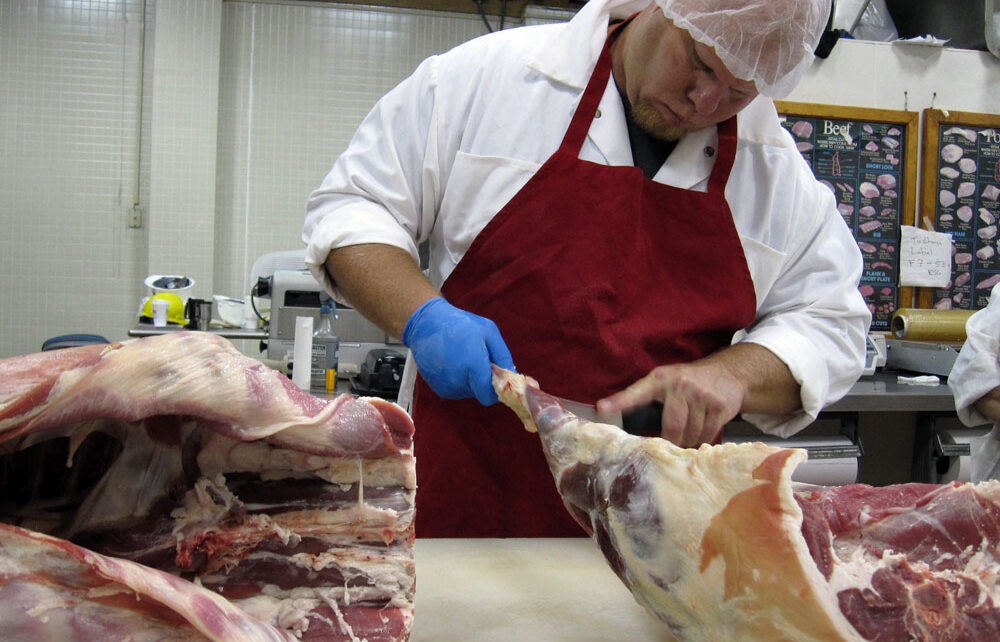Alachua County will spend $2.5M in federal aid on a publicly-owned meat processing facility
By Silas Morgan
The Alachua County Commission unanimously voted at a special meeting Tuesday to spend $2.5 million for a new United States Department of Agriculture-certified meat processing facility in Newberry.
The $2.5 million is part of the $52.25 million in federal funds allocated to Alachua County through the American Rescue Plan Act, the stimulus package passed by Congress and signed into law by the Biden administration in March 2021 to combat the COVID-19 pandemic.
The main proponent of the initiative is Commissioner Anna Prizzia, who has long promoted food accessibility and agriculture-related initiatives.
The meat processing facility will take up 10 acres of land in the Newberry Environmental Park off of County Road 337 and situated near Newberry’s planned regional wastewater treatment plant, which will be used to treat the slaughterhouse’s waste products.
The project is a collaborative effort between Alachua County, the University of Florida’s Institute of Food and Agricultural Sciences and Santa Fe College to support locally produced food, aid small local ranchers and provide agricultural workforce training to those seeking employment.
The initiative is a response to supply chain problems caused by the COVID-19 pandemic. County leaders believe the county should process its meat products locally. The facility is also meant to aid local ranchers, many of whom are not able to get their livestock processed at other facilities due to cost and backup and to provide jobs to those who need them, especially those from disenfranchised communities.
The facility will cost $5.25 million in total, with the remaining funds coming from state grants and private sector funds. The facility will be privately operated but publicly owned. Despite the program’s stated emphasis on aiding local ranchers, the facility is able and expected to support ranchers within a distance of 100 miles from the county, which extends as far as southern Georgia.
It is expected to provide eight to 12 direct jobs at the facility, result in 48 to 72 total jobs from the resulting economic impact, process four to 15 carcasses a day and generate revenues of nearly $5.53 million to $8.29 million annually.
Skilled labor roles at the facility would be paid $55,000 per year and unskilled labor would be paid $40,000 per year. The county said at the meeting the facility estimated annual economic impact in the community would be $10 to $15 million.
Construction for the facility is expected to begin as early as January 2024 and be complete by the end of 2026, after which the facility will begin operating at the beginning of 2027. The project’s next steps are to finalize agreements with Newberry, UF and Santa Fe College and to secure the remaining funding.
The county plans to request capital funding from the state legislature in a joint planning agreement with Newberry. Prizzia plans to meet with state Rep. Chuck Clemons, state Sen. Keith Perry and U.S. Rep. Kat Cammack to secure more support for the project.
Three county residents spoke about the proposal during public comment, and all were against it.
Community activist, nurse and vegetarian Kali Blount said the facility’s meat products would just contribute to an increase in the many food-based illnesses suffered by the local community like diabetes.
He suggested the county instead support a facility involving food products made from sesame-based analogues, and the county was missing out on a chance for important transformation by supporting the plan.
Blount also stated the entire initiative may simply be meant to provide Newberry with enough infrastructure, along with the planned regional wastewater treatment facility, for Newberry to qualify for more federal funds.
County resident Karen Arrington said meat processing work is one of the most dangerous fields, according to the Human Rights Watch nonprofit, and questioned whether or not facility workers would be provided healthcare for employees, including long-term care for potential lost limbs and prostheses.
Commissioner Chuck Chestnut IV had raised concern about potential amputations of fingers prior to public comment.
“We live in a society now where people sue,” he said, though eventually voted in favor of the funding approval.
Arrington also said the funds should be used to help county residents suffering from long-term COVID-19 issues post-infection since it comes from federal aid issued in response to the pandemic.
Former City of Alachua Commissioner Tamara Robbins said county funds shouldn’t go toward an industrial commercial slaughterhouse and the project isn’t doing anything for the local food crisis and isn’t meant to provide aid to local food deserts.
Prizzia also said the project was never about addressing food insecurity but rather food accessibility, despite the project report included in the meeting agenda frequently mentioning food insecurity as a major reason for the facility.
Blount, Arrington and Robbins all criticized the county for its lack of communication and minimal efforts to inform county residents about the project.
Blount said he was shocked to discover that so much had been extensively planned “behind the curtains” for years and that it didn’t feel right for the project to suddenly move quickly now that it had been revealed to the public.
Arrington said she was disturbed that the county had talked and negotiated with everyone except the public, especially since the public is technically the commission’s employers. Robbins said the fact that she had to find out a few days before the meeting is deplorable.
Prizzia said the county made sufficient attempts to inform the community, including mentioning it at public meetings and sending a survey out to local ranchers.
Newly-elected Commissioner Mary Alford, who was selected as the commission’s new vice chair at the beginning of the meeting, said the county could have communicated better to the public and not just ranchers.
Alford and Commissioner Ken Cornell, who was reelected last month, both said they weren’t entirely sure about every aspect of the initiative but voted to approve it anyway.
Alford suggested during general comment at the end of the meeting that the county could potentially adopt a text notification system that residents could sign up for if they wanted to be informed of county initiatives. Alford requested future staff recommendations on how to make broader community conversation possible.
The county report acknowledged that the success of the project depends on the availability and willingness of various communities to participate, for which the county will rely on its nonprofit and higher education partners to continue to work to reach eligible participants through community engagement. The report says the project should proceed despite this due to time constraints, as the federal funds must be spent by the end of 2026.







